Soft White Rolls with Sourdough Discard
I don’t know about you, but I am always looking for another delicious dinner roll recipe. And I am always looking for creative ways to use up my extra sourdough discard (check out a few of my other favorite discard recipes, here, here and here). It’s one of the “hazards” of baking with sourdough I guess…always being on the lookout for somewhere to use that extra! . These soft white rolls with sourdough discard started out as a recipe to reduce waste and now…they are a reason I want to keep my starter fed. Just so I can have discard to make these rolls
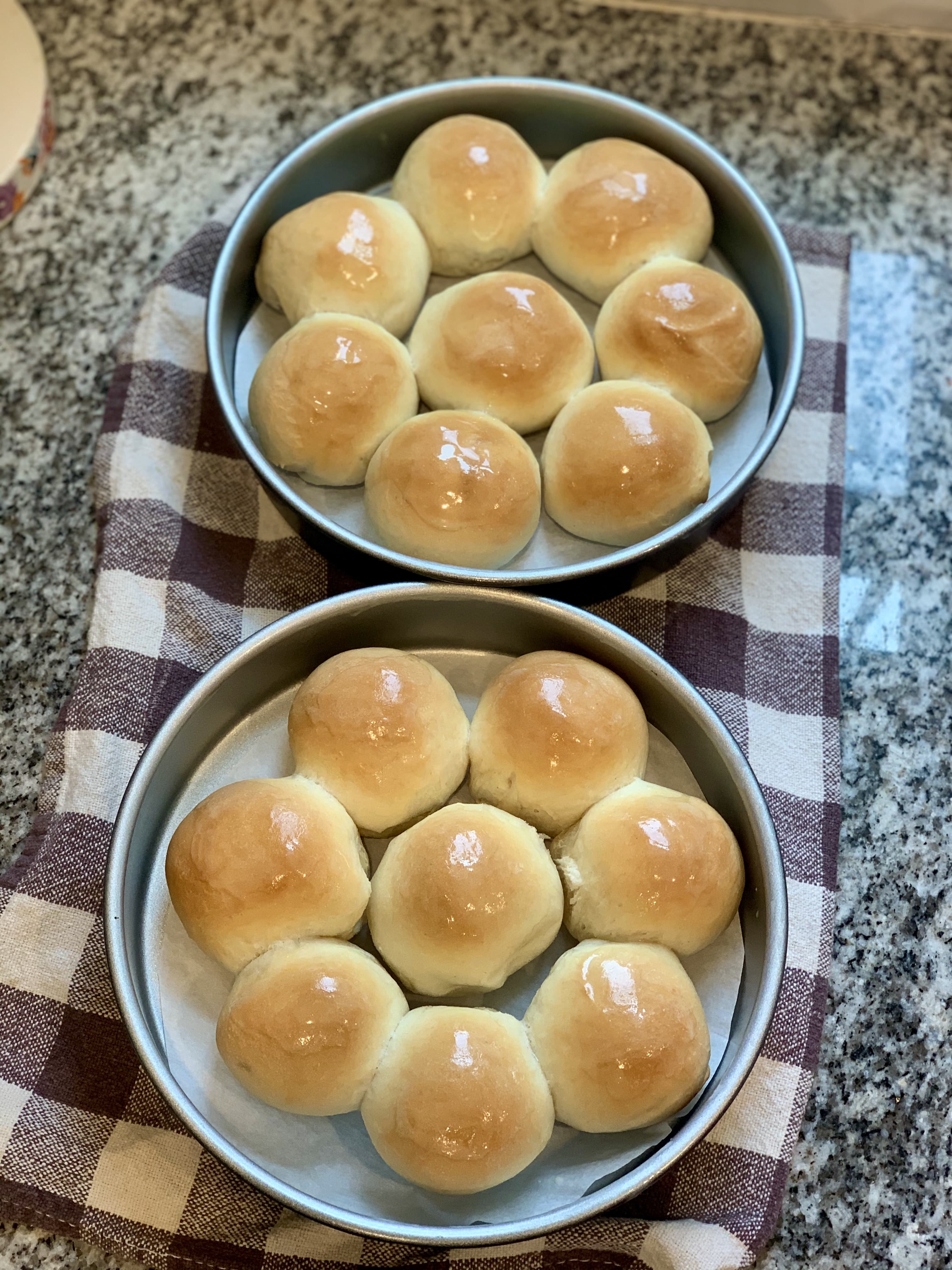
Ingredients in Soft White Rolls with Sourdough Discard
- Sourdough Discard: A lot of sourdough discard is used in this recipe. I use discard where the starter has been fed equal weights of flour and water (100% hydration). The older the discard, the more sour tang will be prevalent in these rolls. If you don’t want any sour flavor, use a fresher discard.
- Milk: 2% or whole milk makes these rolls rich and tender
- Instant yeast: This recipe uses instant yeast to raise the dough
- Sugar: Just a little bit of sugar is added to these rolls to enhance the flavors.
- Unsalted Butter: Melted and cooled unsalted butter allows you to control the salt content in the dough and gives these rolls a rich flavor.
- Salt: Just a little bit of salt tempers the fermentation and brings out the flavor in the rolls. Don’t leave it out.
- Cornstarch: Cornstarch is an unusual ingredient in dinner rolls, but I’ve found it helps give the rolls a super-soft texture.
- Flour: This recipe can be made with all-purpose or bread flour. I prefer bread flour for more chewy rolls and a better rise. But all-purpose works well too.

Why you’ll love soft white rolls with sourdough discard
Super soft, tender, light and a slight tang for the sourdough discard, this recipe for soft white rolls with sourdough discard are sure to be a hit in your family as well. My kids were all begging for seconds when I pulled these out of the oven and popped them on our dinner table a few weeks ago. And I couldn’t blame them. I may have sneaked another one as I was putting the leftovers in a ziplock bag and sticking them in the freezer. I love freezing my bread because it keeps it fresh and I don’t have to see it staring me in the face, begging me to just have one more pinch!

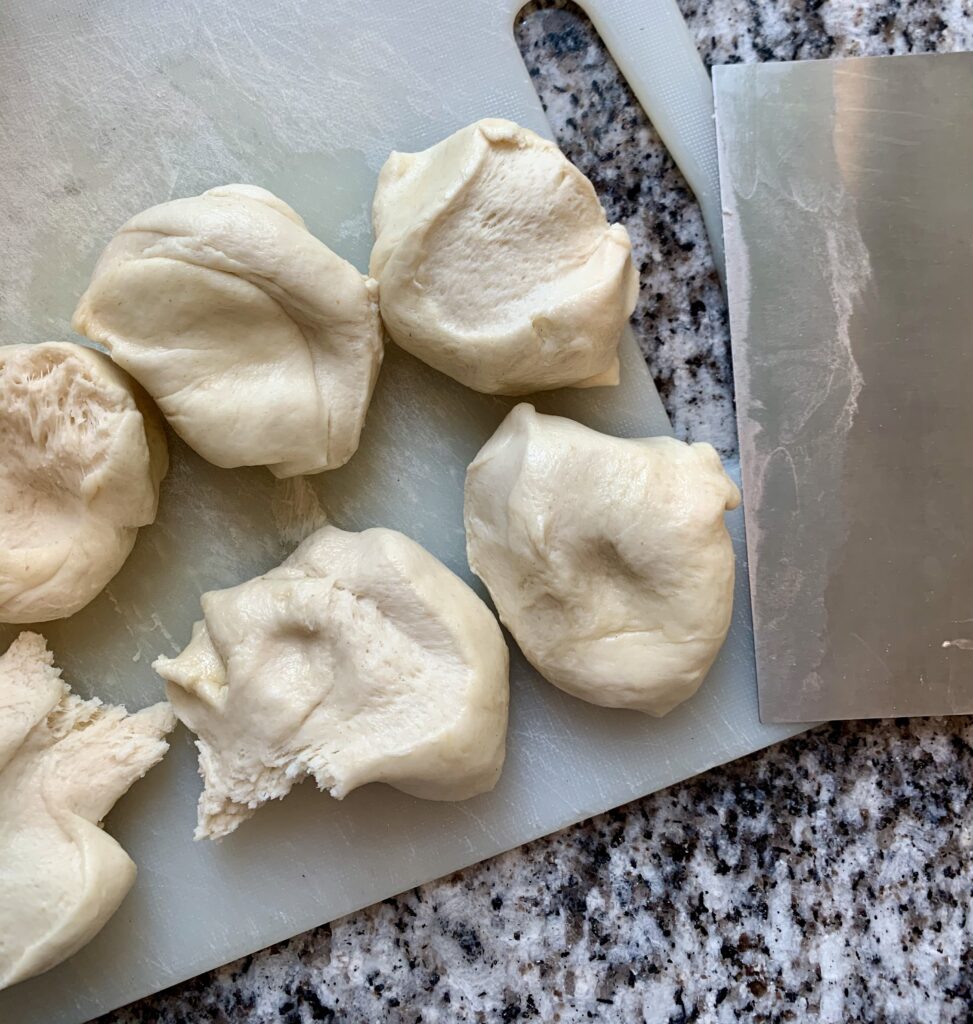
A Few Recipe Tips
The dough for these sourdough discard rolls is very smooth and light. It may take a little longer to rise because it is often made with cold sourdough discard directly from the fridge, but don’t let that stop you from trying out this recipe. Once they are baked, these rolls are slathered with melted butter. I like to take my cold stick of butter and gently run it over the top of the hot rolls. This saves me from having to wash my pastry brush and an extra bowl (can you tell I’m all about saving on the dishes around here?!).
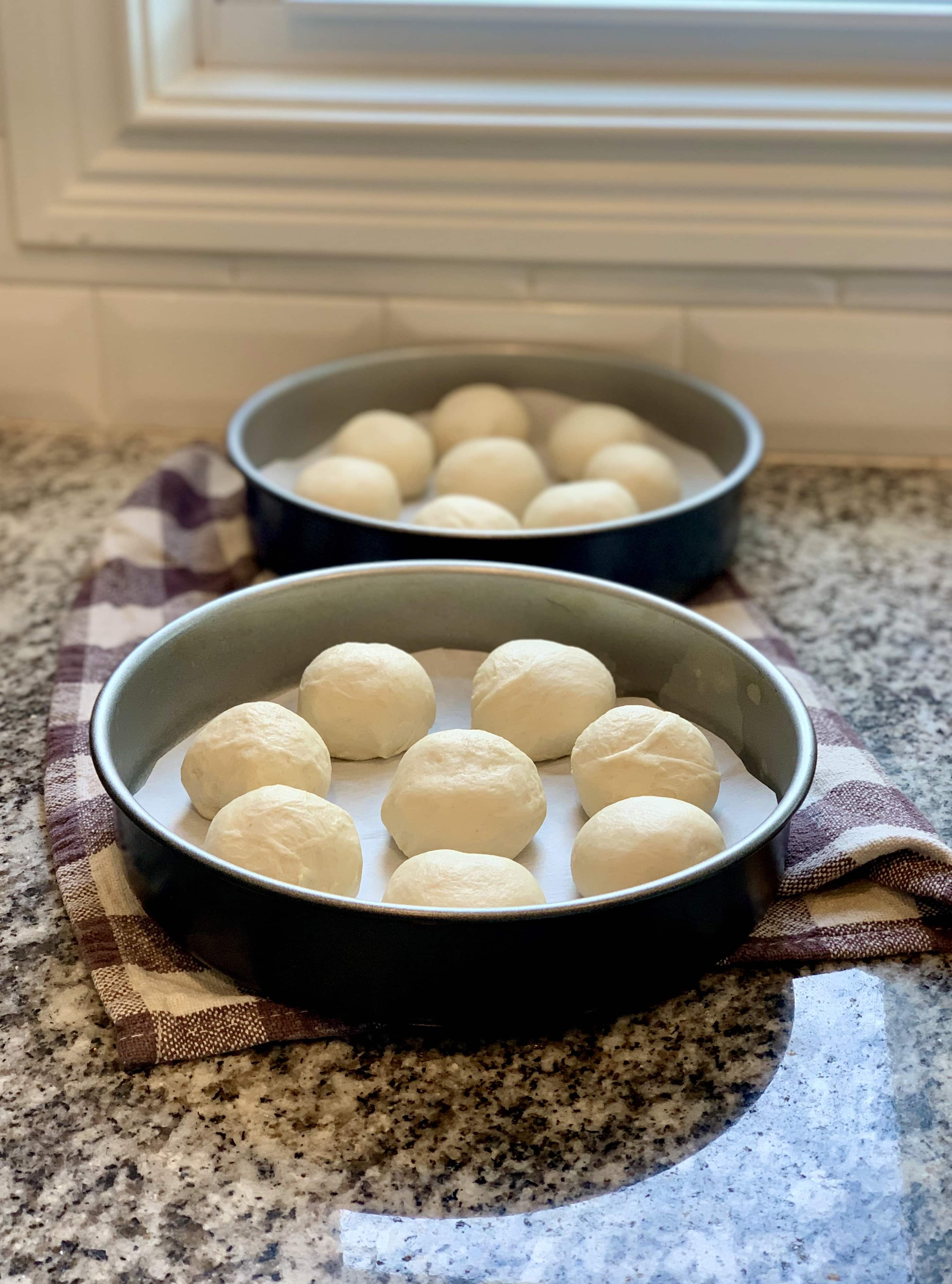

However you choose to eat these rolls: with your dinner, for breakfast with some jam and butter spread on top or as a mini turkey sandwich for lunch, you will love them. I hope you give them a try!
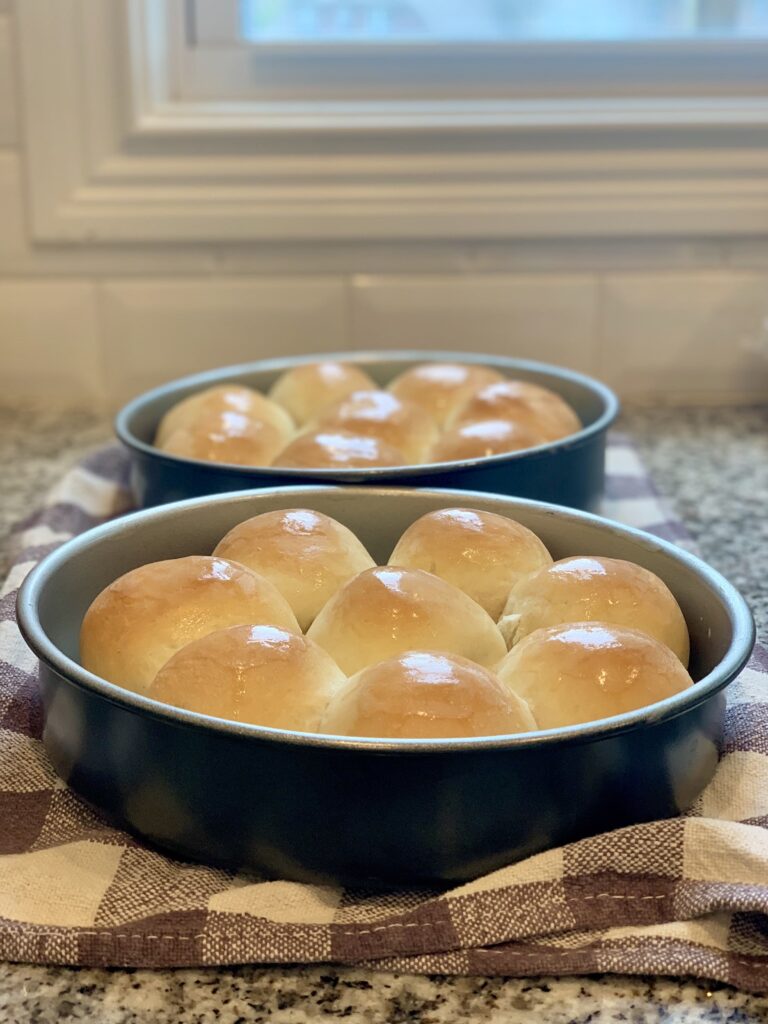
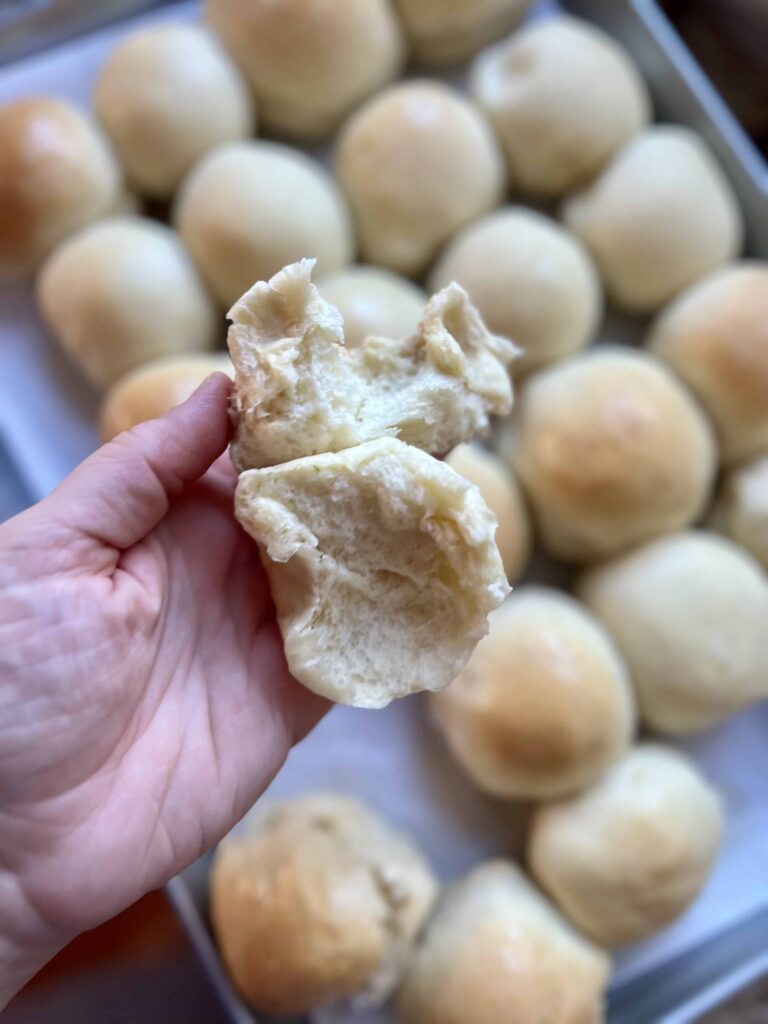
If you liked these rolls, you’ll also like:
Frequently Asked Questions
Once the rolls have cooled completely, store in an airtight container or ziplock bag. Freeze for up to 3 months. Let thaw and warm if desired to serve.
Cornstarch make these rolls extra tender and light. You could substitute potato flakes or just leave them out.
Yes. Make sure the milk is warmed to counteract the cold and allow a little extra time for the dough to rise. Cold dough takes longer to rise, even with commercial yeast.
Yes. You can substitute sourdough starter instead of discard. If you want to make a 100% sourdough version of these rolls, check out my recipe for sourdough dinner rolls here.
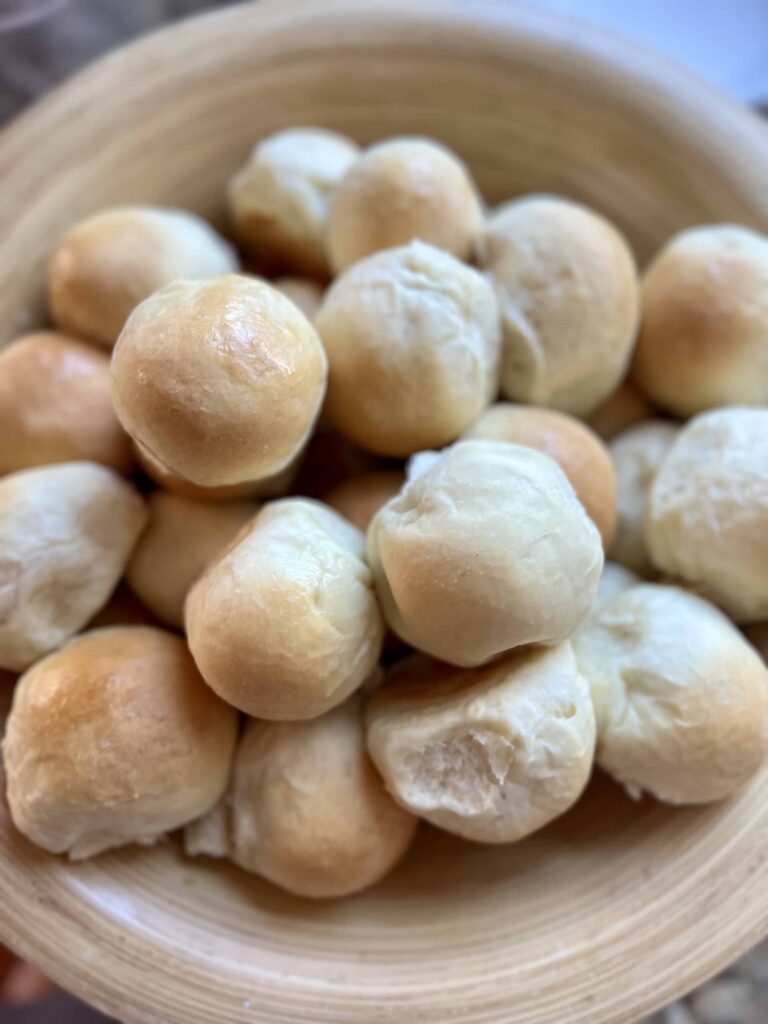
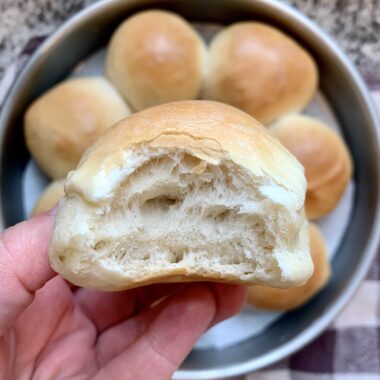
Soft White Rolls with Sourdough Discard
Ingredients
- 165 grams milk lightly warmed, 2/3 cup
- 6 grams instant yeast 2 teaspoons
- 30 grams granulated sugar 2 Tablespoons
- 55 grams unsalted butter melted and cooled, 4 Tablespoons
- 14 grams salt 2 teaspoons
- 225 grams sourdough discard 100% hydration, 1 cup
- 20 grams cornstarch 2 Tablespoons
- 350 grams all purpose or bread flour 2 1/2 cups, see recipe notes
Instructions
- To a stand mixer (or a bowl if you are kneading by hand), mix together the yeast, sugar and warm milk. Let it sit for a minute and use your nose to see if the yeast is working (It will smell very "yeasty" once the sugar and warm milk are mixed in. Technically using instant yeast you can omit this "proofing" step and throw the yeast in the with the flour, but I like to double check that my yeast is working so I do it anyway).
- Add the room temperature melted butter. Make sure it is not too hot so it doesn’t kill the yeast.
- Add the sourdough discard, salt and cornstarch. Begin mixing with your dough hook as you add in the flour a cup at a time. Reserve the half cup of flour to mix in toward the end as you look for readiness of the dough. If the dough is pulling away from the sides, you may not need to add more flour. If the dough is still very sticky, add a little more flour until it is tacky, pulls away from the sides and rolls up into a ball in your fingers (a little stickiness is okay!). This post may help you to check for readiness of dough.
- Knead the dough for about 5 minutes in the stand mixer or 7-10 minutes by hand. I like to set a timer and let the dough hook or mixer do the work for 5 minutes or so.
- Add a drop of oil to a bowl. Shape the dough into a ball and place into the bowl. Roll the ball around until it is completely covered in the oil. (The oil keeps the dough moist as it rises and makes it easier to handle once risen). Cover the bowl with plastic wrap or a kitchen towel and let rise until doubled in size. If your sourdough discard is cold, it may take longer for the dough to rise. You may want to turn your oven light on and let the dough rise covered in the oven (just make sure not to turn the actual oven on during this process).
- Cover the bottom of two 8 or 9 inch cake pans with parchment paper. Alternatively, prepare a half sheet pan (affiliate link for my favorite pans) with parchment paper.
- After the first rise, turn the dough out onto the counter and punch it down. Using a bench scraper or a knife, separate the dough into 16 equally-sized pieces.
- Roll each piece into a ball and place eight dough balls into each pan, for a total of 16 rolls. If you are baking on a half sheet pan, place all the rolls on the same pan. Cover and let rise again in a warm place for about an hour until just about doubled in size.
- Preheat your oven to 350ºF. Bake for about 22-25 minutes until lightly browned on top. Cover the tops with melted butter (I take a stick of cold butter and lightly touch it on the tops of all the rolls). Enjoy warm or freeze for later!

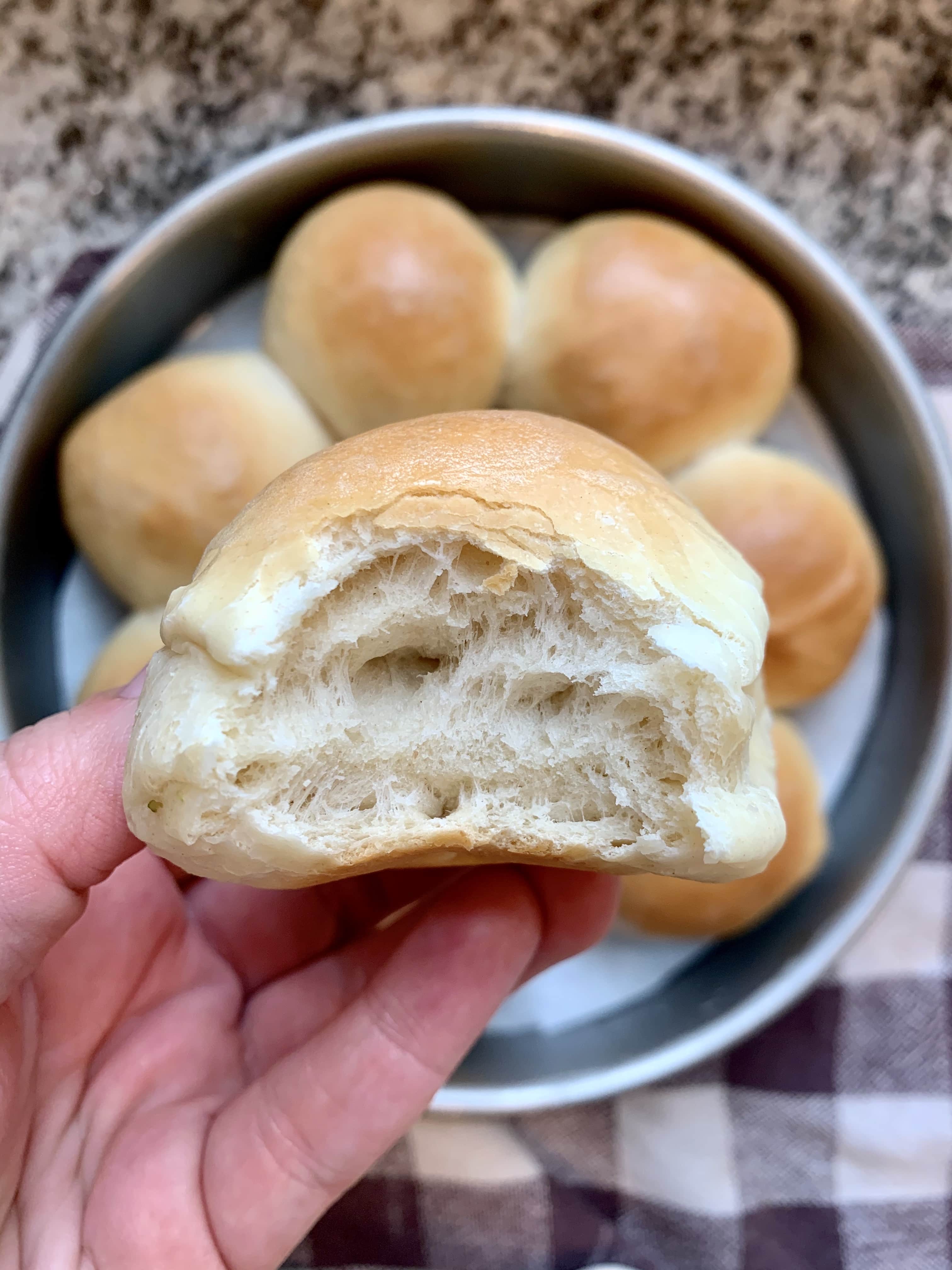

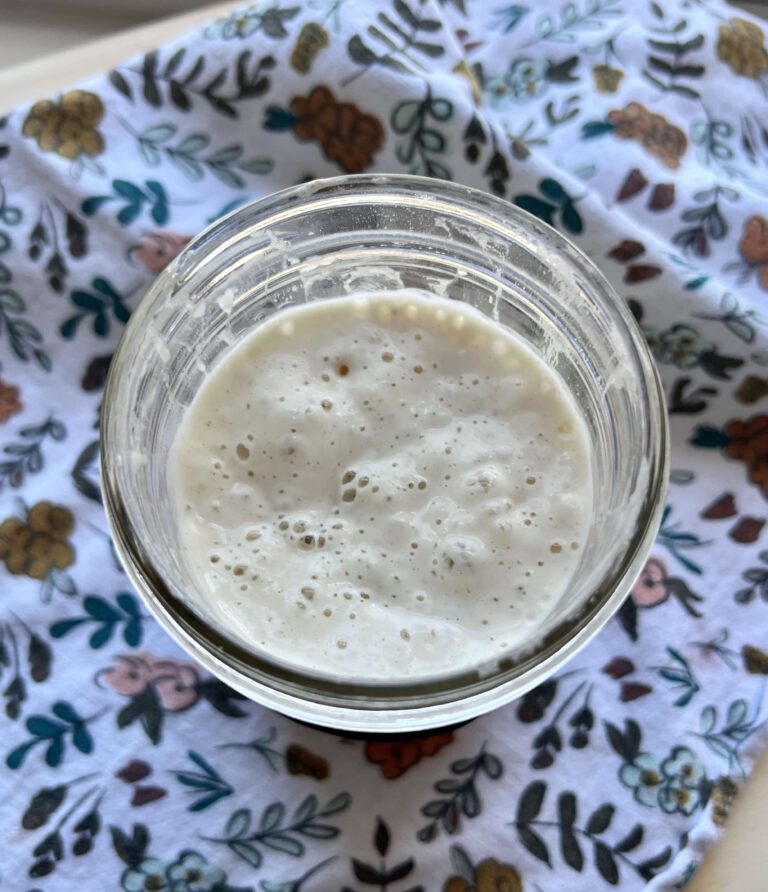
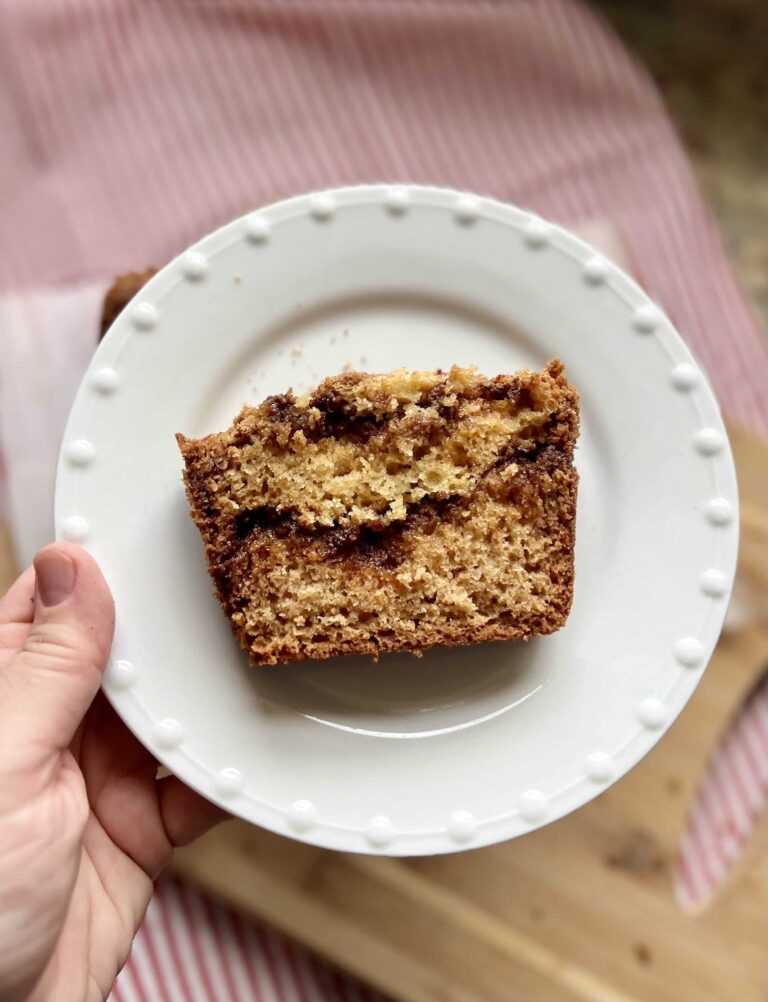

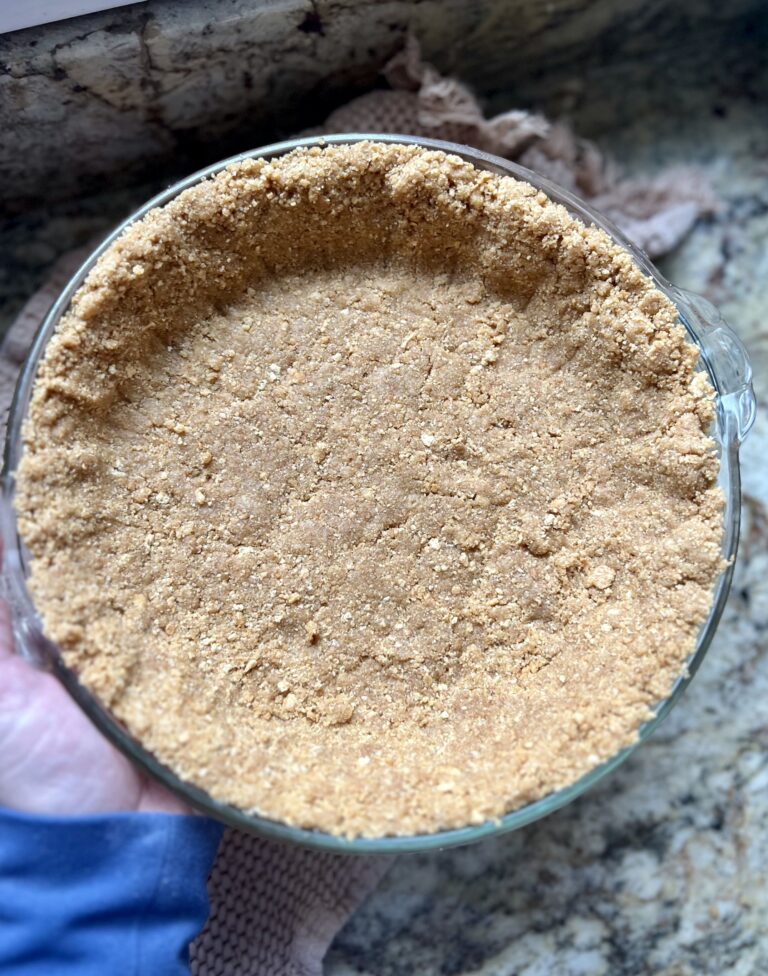

If ever there were a perfect recipe…These are seriously 🙌🏻🙌🏻🙌🏻!! 😋
Question: is it always assumed to use a dough hook on the stand mixer unless you stare otherwise?
Typically if you are making a yeast dough, yes. Usually the recipe will say if you should use a paddle attachment or whisk instead. I typically use the paddle attachment for cakes and cookies. The whisk is for whipped cream or frostings and then the dough hook is for almost all my doughs. Sometimes dough recipes will have you use the paddle attachment if the dough is really wet initially and then more to a dough hook.
If you are using active sourdough can you omit the yeast?
You can, but they will take much longer to proof and then rise again. It really depends on your sourdough starter and how active it is…but typically my sourdough will take 5-7 hours to rise (compared to the 1ish hour with commercial yeast).
Do you mean instant yeast or dry active yeast? I thought instant yeast wasn’t proofed, but mixed in with the flour instead?
I use SAF instant yeast in all of my baking. You technically don’t have to “proof” it but I like to mix it with my liquids before adding flour to make sure it activates. You could just mix it in the with flour if you want to. If you want to use dry active yeast, proof it in warm water with a little sugar for 5 minutes until it bubbles.
I made the dough in my bread machine and covered wth plastic wrap it’s in my fridge, I can’t make the rolls for 3 days will the dough be alright till then ?
It’s worth a try! The longest I usually leave bread in the fridge is about 24 hours before baking.
Why do you add cornstarch?
I think cornstarch helps these rolls with just a little extra softness. I like adding a little cornstarch in cookies too for a really smooth texture.
How long does it usually take to-double in size for the first rise? An hour? And also the second rise once you shape them into balls? Another hour? Just trying to figure out when I should start making the rolls if I make for breakfast. Would I have to wake up super early or can I preshape the dough into balls then stick in the fridge over night and then bake in the morning?
Usually it takes about an hour for the first rise and an hour for the second (depending on the warmth of your kitchen). A few options to speed up the rise or make ahead:
1. Stick the dough or rolls in an oven with the light turned on (don’t turn the oven on, just the oven light). This works kind of like a proofing box and will help the dough and rolls to rise faster.
2. You can stick the mixed dough in the fridge and let the dough rise overnight, then shape into balls in the morning, let them rise (about an hour or so) and bake.
3. You can pre-shape the rolls, stick in the fridge and then pull them out and bring to room temperature and let bake.
An overnight proof in the fridge should increase the sourdough flavor of these rolls. I would probably pick the second option of proofing the dough and then shaping into balls in the morning because I’ve had best results with that method, but you should be able to do any of those. Hope that helps!
Thanks for recipes and clever comments throughout. Think using almond milk would work? Before I try I figured I would ask.
I think almond milk would work just fine. I’ve often substituted almond milk or water in recipes calling for traditional milk with no problem.
Hello! So one day at work a coworker suggested a soup day for the Next day! So I went home after yoga, made a soup and started to make the rolls! It was about midnight and I fell asleep on the couch. My rolls were on the pan, divided out and had risen but I fell asleep too late to make them… in the morning I put them back into a large dough ball and put it in the fridge. What step should I start with to make them? Should I bring it to room temperature and oil a bowl and let it rise again? Then go forth with the remaining steps? Thank you!!! I’m so excited to finish this recipe!
Typically, if my dough has over-proved (or risen too much), I will re-shape the dough and let it rise again. I have never put the dough back in the fridge after this has happened though, so I’m not sure if it will work. I would not re-oil the bowl (it’s okay if you did). Take the dough from the fridge and re-shape the rolls. Let them come to room temperature and see if they rise. If they rise, I would bake them. If they don’t (after coming to room temp), I would start over.
Hi Amy, I am going to try your recipe and wanted to know if you have ever froze the dough after the first rise then shape into balls and freeze at this stage? Thanks and I can’t wait to make these they look delicious.
Denise
I haven’t done that with this recipe but have with others before. You may want to increase the yeast just a bit in the recipe (sometimes yeast will die off a bit in the freezer). Let the rolls come to room temperature and rise before baking. I recommend putting them in your oven with the pilot light on and oven door closed (do not turn on the oven) to let it rise a little quicker. I think it should work. Let me know how you like them!
Is it possible to use an active starter in this recipe? If so, would it be the same amount?
Yes. You can do that. It would be the same amount.
Delicious recipe! I put the rolls on a large baking pan. They turned out kinda flat but still delicious. Next time I will use 2 cake pans so they will be closer together and rise up. I will keep trying until they look like your rolls. Look forward to making more of your recipes.
So glad you liked them! How long did you let them rise the second time? Sometimes if they rise too long they will flatten a bit.